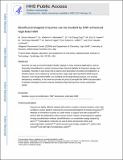| dc.contributor.author | Ravera, Enrico | |
| dc.contributor.author | Martelli, Tommaso | |
| dc.contributor.author | Fragai, Marco | |
| dc.contributor.author | Luchinat, Claudio | |
| dc.contributor.author | Michaelis, Vladimir K. | |
| dc.contributor.author | Ong, Ta-Chung | |
| dc.contributor.author | Keeler, Eric George | |
| dc.contributor.author | Griffin, Robert Guy | |
| dc.date.accessioned | 2018-01-26T16:58:45Z | |
| dc.date.available | 2018-01-26T16:58:45Z | |
| dc.date.issued | 2015-09 | |
| dc.date.submitted | 2015-07 | |
| dc.identifier.issn | 1439-4235 | |
| dc.identifier.issn | 1439-7641 | |
| dc.identifier.uri | http://hdl.handle.net/1721.1/113315 | |
| dc.description.abstract | Enzymes are used as environmentally friendly catalysts in many industrial applications, and are frequently immobilized in a matrix to improve their chemical stability for long-term storage and reusability. Recently, it was shown that an atomic-level description of proteins immobilized in a biosilica matrix can be attained by examining their magic-angle spinning (MAS) NMR spectra. However, even though MAS NMR is an excellent tool for determining structure, it is severely hampered by sensitivity. In this work we provide the proof of principle that NMR characterization of biosilica-entrapped enzymes could be assisted by high-field dynamic nuclear polariza tion (DNP). A closer look at entrapped enzymes: Enzymes entrapped in bioinspired materials are gaining traction in green applications, and solid-state NMR promises to be the technique to study them at atomic detail. However, sensitivity is usually limited. Dynamic nuclear polarization can be applied to increase sensitivity and assess the preservation of the enzyme fold. | en_US |
| dc.description.sponsorship | National Institute of Biomedical Imaging and Bioengineering (U.S.) (Grant EB-003151) | en_US |
| dc.description.sponsorship | National Institute of Biomedical Imaging and Bioengineering (U.S.) (Grant EB-002026) | en_US |
| dc.description.sponsorship | National Institute of Biomedical Imaging and Bioengineering (U.S.) (Grant EB-002804) | en_US |
| dc.publisher | Wiley Blackwell | en_US |
| dc.relation.isversionof | http://dx.doi.org/10.1002/CPHC.201500549 | en_US |
| dc.rights | Creative Commons Attribution-Noncommercial-Share Alike | en_US |
| dc.rights.uri | http://creativecommons.org/licenses/by-nc-sa/4.0/ | en_US |
| dc.source | PMC | en_US |
| dc.title | Biosilica-Entrapped Enzymes Studied by Using Dynamic Nuclear-Polarization-Enhanced High-Field NMR Spectroscopy | en_US |
| dc.type | Article | en_US |
| dc.identifier.citation | Ravera, Enrico et al. “Biosilica-Entrapped Enzymes Studied by Using Dynamic Nuclear-Polarization-Enhanced High-Field NMR Spectroscopy.” ChemPhysChem 16, 13 (August 2015): 2751–2754 © 2015 WILEY-VCH Verlag GmbH & Co. KGaA, Weinheim | en_US |
| dc.contributor.department | Massachusetts Institute of Technology. Department of Chemistry | en_US |
| dc.contributor.department | Francis Bitter Magnet Laboratory (Massachusetts Institute of Technology) | en_US |
| dc.contributor.mitauthor | Michaelis, Vladimir K. | |
| dc.contributor.mitauthor | Ong, Ta-Chung | |
| dc.contributor.mitauthor | Keeler, Eric George | |
| dc.contributor.mitauthor | Griffin, Robert Guy | |
| dc.relation.journal | ChemPhysChem | en_US |
| dc.eprint.version | Author's final manuscript | en_US |
| dc.type.uri | http://purl.org/eprint/type/JournalArticle | en_US |
| eprint.status | http://purl.org/eprint/status/PeerReviewed | en_US |
| dc.date.updated | 2018-01-24T19:23:12Z | |
| dspace.orderedauthors | Ravera, Enrico; Michaelis, Vladimir K.; Ong, Ta-Chung; Keeler, Eric G.; Martelli, Tommaso; Fragai, Marco; Griffin, Robert G.; Luchinat, Claudio | en_US |
| dspace.embargo.terms | N | en_US |
| dc.identifier.orcid | https://orcid.org/0000-0002-6708-7660 | |
| dc.identifier.orcid | https://orcid.org/0000-0003-1589-832X | |
| mit.license | OPEN_ACCESS_POLICY | en_US |
